Documents detailing the proposed Coliseum-anchored Navy Hill redevelopment are now in the hands of Richmond City Council and posted publicly online, revealing more about the $1.5 billion project than previously known – including two new high-rise buildings planned south of Broad Street.
Just days after Mayor Levar Stoney announced his administration was ready to present the proposal after nine months of negotiations, council met in a brief special meeting Monday to introduce ordinances and resolutions required to accommodate the project that would replace the Coliseum with a new arena and transform a 10-block swath of downtown.
Up to this point, that project area for the Navy Hill development – sometimes referred to as the “North of Broad” development – had been defined as the 10 blocks bounded by North Fifth, East Leigh, North 10th and East Marshall streets, save for the two blocks that house the federal building at 400 N. Eighth St. and the John Marshall Courts Building, neither of which would be involved in the project.
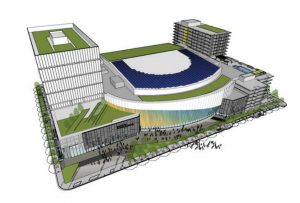
A conceptual rendering of the new arena with the office building to the left and apartments to the right. (City of Richmond)
Now, according to the documents that are posted on the city’s website, the “10 blocks” that make up the project area include two city-owned properties south of Broad Street.
Those properties include 401 E. Broad St., a surface parking lot across from the Greater Richmond Convention Center that would house a new 430,000-square-foot high-rise apartment building, valued at $133.5 million; and the bulk of the city block at 609 E. Grace St., across from the Carpenter Theatre-anchored Dominion Energy Center, where another multistory development totaling 410,000 square feet would be built at a cost of $123 million.
The Grace Street site – previously pitched by another developer for a comparable development that never got off the ground – would be filled with a mix of uses including apartments, a hotel, ground-level retail and structured parking. The existing parking deck at Sixth and Franklin streets, built in 1927 and considered historically significant, would be preserved within the development.
Hints of heading south
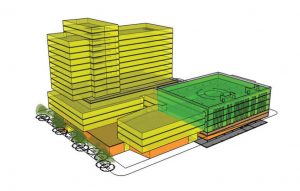
A rendering of the mixed-use development proposed in the 600 block of East Grace Street. (City of Richmond)
While not mentioned when the project was presented last November, the south-of-Broad sites had been hinted at in remarks by Tom Farrell, the Dominion Energy CEO leading NH District Corp., the nonprofit group of local business leaders pushing the Navy Hill project.
In an interview following that November announcement, in which Stoney formally endorsed the proposal, Farrell told Richmond BizSense that an expanded TIF district – the tax-increment financing district that would help fund Navy Hill – was needed in part to involve more property to accommodate the project’s affordable housing component, which now calls for 480 housing units reserved for households earning up to 80 percent of the area median income.
That number is lower than the 680 affordable housing units announced in November, though the plans presented Monday retain a core of 280 income-based units that are to be built within the north-of-Broad project area. The proposal now states that potentially hundreds more income-based units would be built elsewhere downtown, funded with surplus revenues and philanthropic support. Specifically, an additional 200 outside the project area would be funded with $10 million from The Community Foundation and Atlantic Union Bank.
Those units are in addition to more than 2,000 market-rate apartments planned as part of Navy Hill, which also calls for a 541-room hotel, a new GRTC transfer center, a renovated Blues Armory building with a food hall and ballroom, and the new arena – a $235 million facility that, at 17,500 seats, is planned to be the largest in Virginia.
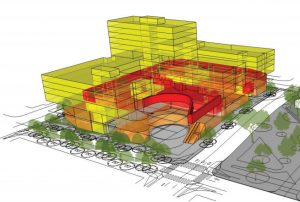
A rendering of the development that would replace the social services building on Ninth Street. (City of Richmond)
The two south-of-Broad sites are within the enlarged TIF district, proposed to span much of downtown bordered to the west and east by First and 10th streets, and to the north and south by Interstate 64-95 and the Downtown Expressway. That area includes the new Dominion Energy tower on South Sixth Street and the site of the company’s planned sister tower nearby.
The 401 E. Broad St. parking lot is included among city-owned properties that would be declared surplus and conveyed to NH District Corp. as part of the proposed development agreement. A small part of the Grace Street site – three parcels at 112-116 N. Seventh St. – also are included on that list.
The rest of the Grace Street property that makes up 609 E. Grace St. would be sold to NH District Corp. as stipulated in the agreement.
Five-year window
The ordinances presented Monday state that, should the development agreement receive council approval, the sale of city-owned properties across the project area would produce $15.8 million that would be initially held in escrow and later directed to the city’s capital reserve fund for public improvements after the Navy Hill parcels are developed. The overall project is projected to be completed five years from now.
Over 30 years, Navy Hill is projected to generate $1.5 billion – the same amount as the latest project cost estimate – in various incremental tax revenues resulting from the development.
Documents submitted Monday also detail development planned for different blocks within the north-of-Broad area. The Coliseum would be replaced with the new arena flanked by an office building along Fifth Street and apartments with ground-level retail along Seventh Street. Additional apartments and retail would be added to the arena-facing sides of two existing parking decks.
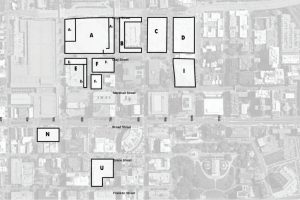
A map of the project area, which now includes two parcels south of Broad Street. (NH District Corp.)
The GRTC transfer center would fill the surface parking lot across Clay Street from the courts building, along with underground parking and ground-level retail, a deck park, and housing and office uses. The public works building would be replaced with research, office, parking, hospitality and ground-level retail uses, while the social services building – to be relocated to another site downtown providing the agency with 130,000 square feet of space – would be replaced with apartments, parking and retail or office.
Monday’s introduction starts a 90-day process for council’s appointed Navy Hill advisory commission to review the documents, meaning a public hearing and potential vote may not occur until November. Ordinances related to updating and extending the city’s CM zoning district to accommodate the project were referred to the Planning Commission, which is scheduled to take those up at its Sept. 3 meeting.
Documents detailing the proposed Coliseum-anchored Navy Hill redevelopment are now in the hands of Richmond City Council and posted publicly online, revealing more about the $1.5 billion project than previously known – including two new high-rise buildings planned south of Broad Street.
Just days after Mayor Levar Stoney announced his administration was ready to present the proposal after nine months of negotiations, council met in a brief special meeting Monday to introduce ordinances and resolutions required to accommodate the project that would replace the Coliseum with a new arena and transform a 10-block swath of downtown.
Up to this point, that project area for the Navy Hill development – sometimes referred to as the “North of Broad” development – had been defined as the 10 blocks bounded by North Fifth, East Leigh, North 10th and East Marshall streets, save for the two blocks that house the federal building at 400 N. Eighth St. and the John Marshall Courts Building, neither of which would be involved in the project.

A conceptual rendering of the new arena with the office building to the left and apartments to the right. (City of Richmond)
Now, according to the documents that are posted on the city’s website, the “10 blocks” that make up the project area include two city-owned properties south of Broad Street.
Those properties include 401 E. Broad St., a surface parking lot across from the Greater Richmond Convention Center that would house a new 430,000-square-foot high-rise apartment building, valued at $133.5 million; and the bulk of the city block at 609 E. Grace St., across from the Carpenter Theatre-anchored Dominion Energy Center, where another multistory development totaling 410,000 square feet would be built at a cost of $123 million.
The Grace Street site – previously pitched by another developer for a comparable development that never got off the ground – would be filled with a mix of uses including apartments, a hotel, ground-level retail and structured parking. The existing parking deck at Sixth and Franklin streets, built in 1927 and considered historically significant, would be preserved within the development.
Hints of heading south

A rendering of the mixed-use development proposed in the 600 block of East Grace Street. (City of Richmond)
While not mentioned when the project was presented last November, the south-of-Broad sites had been hinted at in remarks by Tom Farrell, the Dominion Energy CEO leading NH District Corp., the nonprofit group of local business leaders pushing the Navy Hill project.
In an interview following that November announcement, in which Stoney formally endorsed the proposal, Farrell told Richmond BizSense that an expanded TIF district – the tax-increment financing district that would help fund Navy Hill – was needed in part to involve more property to accommodate the project’s affordable housing component, which now calls for 480 housing units reserved for households earning up to 80 percent of the area median income.
That number is lower than the 680 affordable housing units announced in November, though the plans presented Monday retain a core of 280 income-based units that are to be built within the north-of-Broad project area. The proposal now states that potentially hundreds more income-based units would be built elsewhere downtown, funded with surplus revenues and philanthropic support. Specifically, an additional 200 outside the project area would be funded with $10 million from The Community Foundation and Atlantic Union Bank.
Those units are in addition to more than 2,000 market-rate apartments planned as part of Navy Hill, which also calls for a 541-room hotel, a new GRTC transfer center, a renovated Blues Armory building with a food hall and ballroom, and the new arena – a $235 million facility that, at 17,500 seats, is planned to be the largest in Virginia.

A rendering of the development that would replace the social services building on Ninth Street. (City of Richmond)
The two south-of-Broad sites are within the enlarged TIF district, proposed to span much of downtown bordered to the west and east by First and 10th streets, and to the north and south by Interstate 64-95 and the Downtown Expressway. That area includes the new Dominion Energy tower on South Sixth Street and the site of the company’s planned sister tower nearby.
The 401 E. Broad St. parking lot is included among city-owned properties that would be declared surplus and conveyed to NH District Corp. as part of the proposed development agreement. A small part of the Grace Street site – three parcels at 112-116 N. Seventh St. – also are included on that list.
The rest of the Grace Street property that makes up 609 E. Grace St. would be sold to NH District Corp. as stipulated in the agreement.
Five-year window
The ordinances presented Monday state that, should the development agreement receive council approval, the sale of city-owned properties across the project area would produce $15.8 million that would be initially held in escrow and later directed to the city’s capital reserve fund for public improvements after the Navy Hill parcels are developed. The overall project is projected to be completed five years from now.
Over 30 years, Navy Hill is projected to generate $1.5 billion – the same amount as the latest project cost estimate – in various incremental tax revenues resulting from the development.
Documents submitted Monday also detail development planned for different blocks within the north-of-Broad area. The Coliseum would be replaced with the new arena flanked by an office building along Fifth Street and apartments with ground-level retail along Seventh Street. Additional apartments and retail would be added to the arena-facing sides of two existing parking decks.

A map of the project area, which now includes two parcels south of Broad Street. (NH District Corp.)
The GRTC transfer center would fill the surface parking lot across Clay Street from the courts building, along with underground parking and ground-level retail, a deck park, and housing and office uses. The public works building would be replaced with research, office, parking, hospitality and ground-level retail uses, while the social services building – to be relocated to another site downtown providing the agency with 130,000 square feet of space – would be replaced with apartments, parking and retail or office.
Monday’s introduction starts a 90-day process for council’s appointed Navy Hill advisory commission to review the documents, meaning a public hearing and potential vote may not occur until November. Ordinances related to updating and extending the city’s CM zoning district to accommodate the project were referred to the Planning Commission, which is scheduled to take those up at its Sept. 3 meeting.
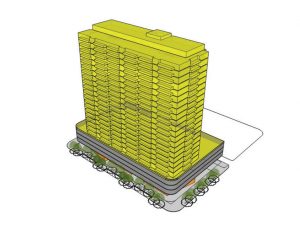
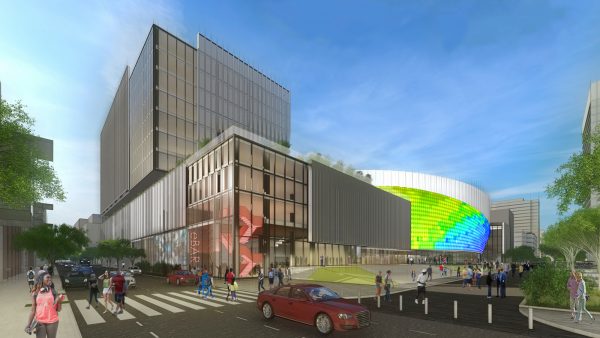
What a horrible, awful, crony project. We don’t even have enough money to cover the wear and tear and citizen usage of public infrastructure at this current density level. But now they want to increase the density and apply all additional taxes towards paying down a development project that was never on the open market?!?! I mean, how dumb are we… While the concepts sound cool, excpet for where will all these people be parking, the reality is the numbers don’t align. This is being forced at this point and it is a pathetic in our face slap of cronyism… Read more »
Did you read the 589 page plan to see how numbers align? They addressed so many things and I see potential. I don’t know much about taxes, bonds, financing, zoning, etc., but this is what RVA is missing and I’m glad someone with money stepped up to make it happen. It looks like they have amazing ideas for the downtown space and I’m hopeful it succeeds.
I sure did Zach, after a citizen had to go to court amd pay money to have them released since Stoney wouldn’t do it on his own accord. Have you? You should, the numbers tell quite a story, or nightmare if you are rooted in reality.
Has anyone reviewed the arguments laid out against this plan on this website ? Interesting read.:
https://nocoliseum.com/breakdown-of-citys-overview/
Bob: thanks for posting this link. One thing that jumps out at me: -” These Sales Tax numbers are also based off of 58 ticketed events a year at the new Coliseum. DC only does around 30-35 a year when you take out the sports teams.” While I agree it would be NICE to have a better downtown arena, I don’t see how it’s more important than schools, mass transit, drug addition treatment programs, or about 90 other things. Does anyone really think that this new stadium is going to have more than an event a week? Where is everyone… Read more »
What a bloodless draft of architectural mediocrity. I’m all for the re-inhabiting of downtown but not if it means erecting glass, steel and reinforced concrete towers that look like the glass, steel and reinforced concrete towers going up in every other gentrifying city in this country. Come on, RVA has much more personality than this crud.
John Gerencser While I agree new modern buildings have little architectural appeal, north of Broad is good for experimenting. I like that the arena is attached and anchored by two buildings. The area south of Broad, well there the buildings should be elegant and fit in with the current styles, or at a minimum enhance them. What I feel is more important is what do the city and the developers want downtown to become? A living area, an office area, a hybrid mixture of both. I favour the last one, but then shopping most definitely needs to be added to… Read more »
So basically you’re taxing existing buildings to build a new one, taxing existing businesses to fund the competition?
“North of Broad”
“Two towers south of Broad”
Okay…